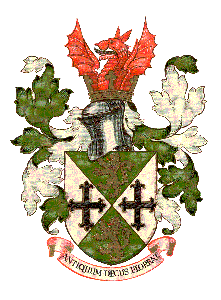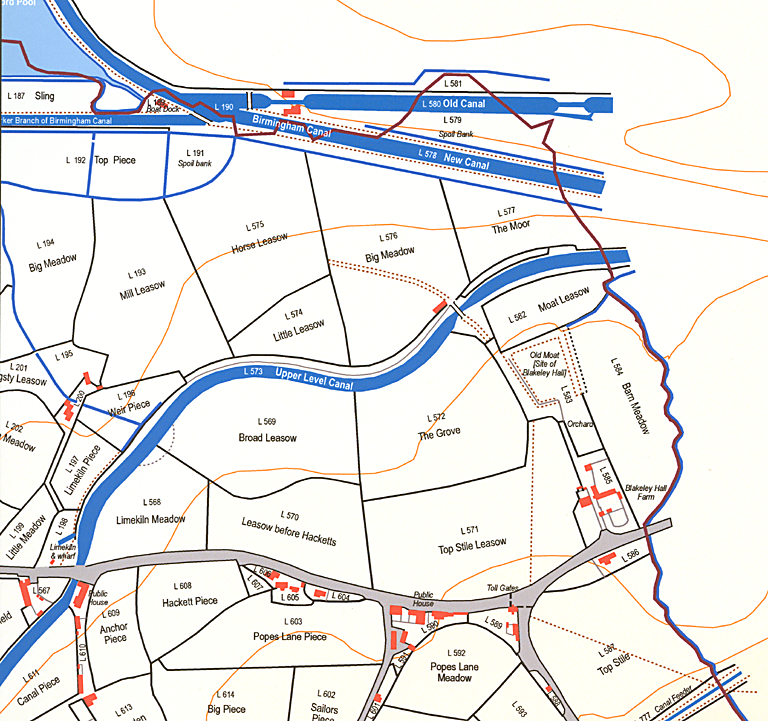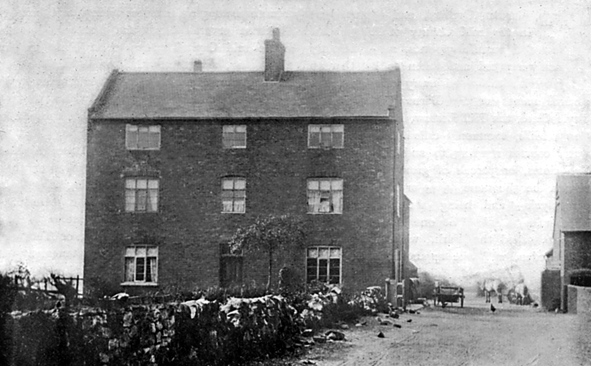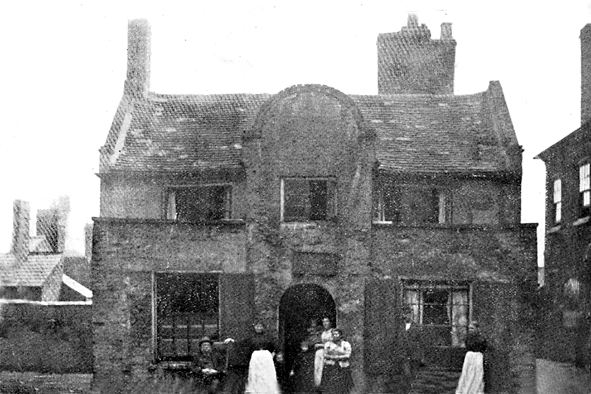
|
History
of Oldbury, Langley and Warley
|
||
|
Communities
of the West Midlands
|
||
|
The
website of Langley Local History Society - Oldbury Local History
Group - Old Warley Local History Society
|
||
 |
||
| HOME | |
| NEWS & EVENTS | |
| HISTORY SOCIETIES | |
| PUBLICATIONS | |
| GALLERY | |
| QUESTIONS | |
|
article 002 BLAKELEY HALL - OLDBURY MANOR HOUSE |
Blakeley Grange There is no record of the building of Blakeley Hall which was a grange of Hales Owen Abbey from the 13th to the 16th century. The building may have been erected by the Abbey, which was founded in 1216, or it may have existed before the Abbey and simply been taken over by the Abbot. The Pipe Rolls of Henry II record payments of 28s 6d from the farm at Oldbury to the exchequer from 1166 to 1173: this may have been the farm associated with Blakeley Hall, but this is not stated. 'Blakeley' appears as both a place name and a personal name at least as early as 1270, when the people of Walloxhall reported Ranulph of Blakeley for carrying off some of the Abbot's fences at Blakeley [1]. In a Lyttleton document dated 1291, Blakeley is first mentioned as a grange of the Abbey [2]. By 1302 there was a mill at Blakeley, and the miller there, with other millers in the manor, was asked to swear to new rules for the grinding of malt. [3] In 1339 John Hawket was licensed to have mass said in his private chapel at Blakeley Grange [4]. Four years later the grange was let by the Abbot to John Wallockshall, subject to various conditions, including one about taking water from the 'Stour': Blakeley Grange was close to the headwaters of the 'Tame', not the 'Stour', but the stream may have been named differently in the 1300s [5]. In 1414, John Porter, Vicar of Kidderminster, was granted five granges, including Blakeley, on a sixty-year lease. [6] These references present a very sketchy picture of Blakeley Grange when it was held by the Abbey, but it was clearly a place of some importance and probably the 'eyes' of the Abbot in the Oldbury area, since he was based four miles away at Halesowen Abbey itself. When the Abbey was surrendered to Henry VIII in 1538, Blakeley Grange passed as part of Hales Owen Manor to Sir John Dudley. In 1557 his son, Richard Dudley, separated Oldbury Manor from the remainder of Hales Owen Manor, selling the main part, but keeping Oldbury Manor for himself. As one of the largest houses in the new manor, Blakeley Grange became the manor house for Oldbury. The Dudleys and their immediate heirs, the Robsarts, did not use Blakeley Hall as a house for themselves, and let it out with the remains of the demesne lands around it as a farm. Lyttleton papers suggest that Edward Banburye was the lessee in 1630. [7]
Blakeley
Hall In 1633, Charles Cornwallis bought the manor, and the family seems to have spent some time in Oldbury, probably at Blakeley Hall. His father-in-law, Edward Colmore, is described as being 'of Blakely Hall' in his will of 1640. [See article 001 for details of the descent of the manor] Subsequent Lords and Ladies of the Manor were absentee landlords, with the Hall and its surrounding lands again leased out as a farm. An entry in the Halesowen Parish Registers for 19th September 1701 records the burial of 'John Hopkins of Blackley Hall', suggesting he was an early tenant. There are no records of the house apart from an indenture of 1713 transferring it from William Fetherston to his son-in-law William Addington.[8] 'Blackley Hall' [sic] was described as being surrounded by barns, stable buildings, garden, orchard and appurtenances, and a string of fields: Barne Croft, Moore Rough, Blackley, Grove Close, the Pool Tayle Close, Hill Leasow, Lower Blackley and Great Meadow. Some of the fields could be identified on the Tithe Map 130 years later. With it went the '… water Corne Mills, commonly called Oldbury Mills, and the Mill Pool…' and two closes near the mill.
In 1772 the first canal arrived, intended to carry coal and goods between Birmingham and the Black Country. It was a contour canal built by James Brindley, and its line brought it within about 150 yards of Blakeley Hall. Canal company documents record the transfer of land from 'Frances Wright and another' in an indenture dated 31 August 1772, less than a month before the new canal was opened. Shortly afterwards, the old building was demolished and a new three-storey Georgian farmhouse erected close to the toll gate on the recently turnpiked road from Birmingham to Dudley. [9]
There are no plans or descriptions of the old Hall, except a reference in Reeves' 'History of West Bromwich' as "a fourteenth century half-timbered building with a moat round it". He claims to have seen the moat full of water in March 1829. The 1843 Tithe Apportionment plan for Oldbury shows an apparently empty, roughly square moat. Hutton writing originally in 1783 says of the Hall: "Five miles north west of Birmingham, is Blakeley Hall, the manor house of Oldbury. If we see a veritable edifice without a moat, we cannot from thence conclude, it was never the residence of a gentleman, but wherever we find one we may conclude it was … The present building seems about three hundred years old … In 1769, the Birmingham Canal passing over the premises, robbed the trench of its water." [10] The 1857 Bates map of Oldbury and later Ordnance survey maps show the new buildings of Blakeley Hall Farm but no indication of the moat, suggesting it may have been ploughed out in the 1840s and 50s.
The Bailiff's House A second building associated with the manor was the house used by the bailiffs, situated on the main highway in Oldbury town between the Old Court House and the Wesley Chapel in Church Street. Little is known about the origins of the building, which was latterly termed 'The Manor House'. It was demolished around1904, by which time it had become a lodging house. McKean [11] quotes an article on the Manor House from the "Birmingham Weekly Post, 5th August 1899:
"The Old Manor House, which is situated in one of the busiest parts of the town of Oldbury, is a very ancient building, and bears traces of having at one time occupied an important place among the family mansions, which centruries ago were to be found studded about the beautiful tract of country known as the Stour Valley. Standing back from the main road from Halesowen to West Bromwich a convenient distance, and by the side of the Old Court House, it may escape the notice of most of the people who frequent that locality. Probably early in the eighteenth century it took its rank amongst the chief houses of the district, and in the early part of this century [the eighteenth] was the residence of a medical man named Cooper, who was very popular in the district. The old house was surrounded by extensive pleasure grounds and an orchard; but all these have been stripped away by thehand of the builder, and are now occupied by the working classes. For at least fifty years the house has been used as a common lodging-house. It is supposed that it was, for a time at least, associated with the old County Court. In the latter building debtors were formerly imprisoned for debt, and the debtors used to be supplied with food from the Old Manor House. On one occasion, during a Colliers' riot in the Black Country, the mob attacked both the Court buildings and the Manor House, and the prisoners were liberated and escaped the penalty of their indebtedness."
References
This article © Dr Terry Daniels 2008 - contact for permission to reproduce |
|||||||||||||||||||||||||||||||||||||||||


